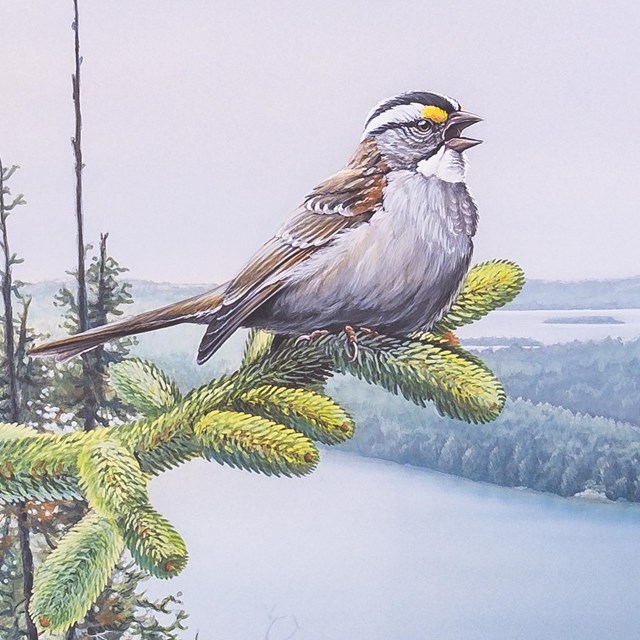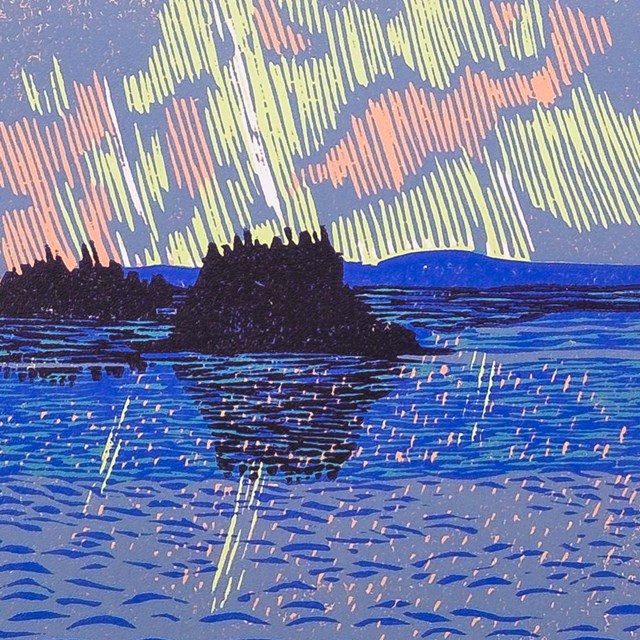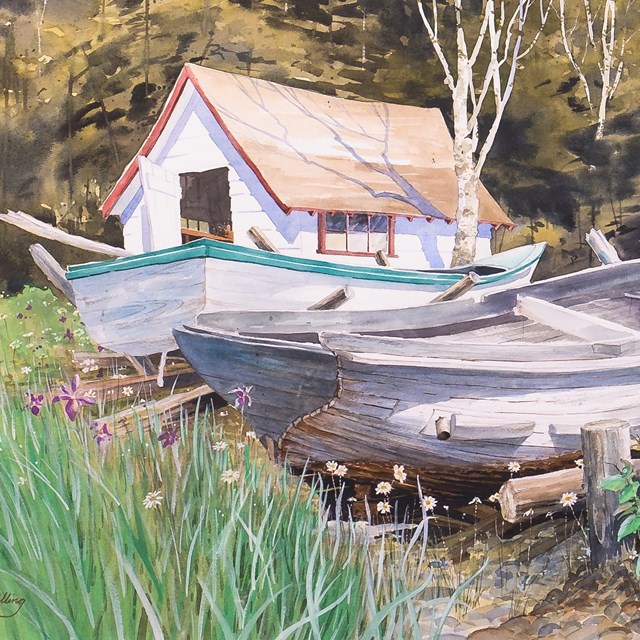
COURTESY TRACY ZEMAN Isle Royale ReflectionThe loons’ yodels and tremolos measured my time on the island and in the Dassler. I heard their wild calls when I cooked on the camp stove in the cabin, scrambled over the rocks in the cove and on Scoville, paddled in Tobin Harbor, and lounged on the bench at the top of the bluff. I wrote in my notes, “mist this morning over ridge, loons, coffee, trying to start a fire.” Another day: “9:46 AM, loons calling, I go out to see, too far—near Merritt Lane maybe—notice the wild strawberry runners behind the cabin.” Scribbled in the margin, I comment “loons calling singly and with others,” and “loons all the time, chickadees, red-breasted nuthatches busy outside,” and “loon again, 5:32 PM.” One night, we canoed back from Rock Harbor as dusk came on. The lake was still and glassy. The trees turned black. The forested islands transformed into dark outlines against gray blue water and gray blue sky. When we thought we heard a wolf howl, we stopped paddling and talking and listened. After a few quiet moments this huge cacophony began—nearby a group of loons were flapping their wings and making loud rapid noises. It went on for a few bewildering minutes. Later I wondered if it was some kind of staging or gathering behavior as they prepared to head to points south for the winter. As my days on the island came to a close, so did the loons’—“3:31 loon call, windy, I wonder if they are leaving, I hear fewer of them.” I heard loons many times before, on the Great Lakes, and smaller lakes in Michigan and Wisconsin, but I never stayed somewhere long enough to feel that I lived with them, co-existing among the archipelago’s wind, water, and rock. As I packed up to head home, they prepared to migrate, our journeys south overlapping in time. - Tracy Zeman, 2022 Introduction to "Removals and Remainders on ISLE ROYALE"I visited Isle Royale to be near its wolves, to hear them at night, to tread their same ground. I knew it was unlikely that I would see them-- almost no one does. And I knew what it meant that they were there. The islands' wolves are, in a sense, remainders of previous ecologies, of when colder winters meant more lake ice on which to cross to the islands, and of even earlier centuries when wolves roamed the continent from coast to coast before settler-colonialism and the subsequent persecution and elimination of wolves from most of the lower 48 states. The archipelago itself, tucked into the northwest corner of Lake Superior, is also a remainder-- a remainder of previous geological eras dominated by ancient lava flows then mile-thick glaciers expanding and receding. Donna Haraway, in Staying with the Trouble, recounts stories of "finite flourishing" in damaged worlds by illustrating the complex relationships between things. In lines of connection, in endings and beginnings, there is both living and dying, and opportunities to co-inhabit and to seek out other, less deadly patterns. By tracing the outlines of wolf, rock, loon, in a partially wild and partially constructed space, I map patterns old and new.
About the ArtistTracy Zeman spent two weeks on Isle Royale as an Artist-in-Residence in September of 2022. Her first book, Empire, which traces the destruction of the tallgrass prairie during the settler-colonial period, won the New Measure Poetry Prize from Free Verse Editions. Her poems have appeared in Beloit Poetry Journal, Chicago Review, Denver Quarterly, and other journals, and her essays, book reviews, and interviews have been published in Kenyon Review, The Cincinnati Review, Terrain.org, and others. Zeman has earned residences from the Sitka Center for Art and Ecology, Ox-Bow School of Art and Artist Residency, The Wild, and others. Her recent work documents the biodiversity and climate crises in the Great Lakes Basin. She teaches writing at the University of Michigan and literature in U-M’s remote New England Literature Program. Originally from Illinois, Zeman currently lives outside Detroit, Michigan, with her husband, daughter, and dog, where she hikes and bird watches in all seasons. You can view more of Tracy Zeman's work on the artist's personal webpage.
|
Last updated: March 11, 2024



